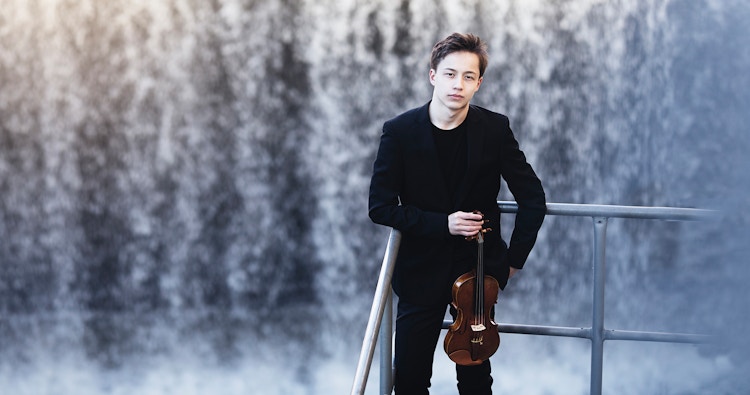Crescendo Mahler Bruch
The Wondrous World of Mahler

The Wondrous World of Mahler
The Oslo Philharmonic and Young Philharmonic perform Mahler’s Symphony No. 1, and Johan Dalene is the soloist in Max Bruch’s Violin Concerto.
Mahler pronounced that “a symphony must be like the world − it must embrace everything”, and already from the very first bar of Symphony No. 1, he creates a sound so evocative, which appears so infinite and vast, that it seems as magnetic today as when the Oslo Philharmonic played it for the first time in Norway in 1919. The work swings between the banal and the noble and is, in short, a whole world unto itself. Eivind Aadland brings talented young players to the orchestra for this concert, as well as the gifted Swedish violinist Johan Dalene, who performs Max Bruch’s gorgeous Violin Concerto.
Frère Jacques, Frère Jacques, dormez vous? The well-known children’s song is not exactly an obvious starting point for either a funeral march or a symphonic movement, but Gustav Mahler (1860−1911) was also known for producing the unexpected. In the third movement of his Symphony No. 1 (1888), Frère Jacques appears, in a minor key, played by a solo double bass over a chilling accompaniment by the timpani; a starting point for the strange musical mysticism that Mahler was a master of creating.
The slow movement is far from the only surprise in the symphony. Already in the first movement, traditional forms and patterns constitute only a vague framework for Mahler’s melodic and formal experiments, which include off-stage trumpets and other elements. The Austrian ländler, in Mahler’s colourful and unpredictable guise, would prove to be another of his symphonic trademarks, and already in the second movement of his first symphony, this is established as a significant footprint and a break with tradition. The same is true for the violently dissonant opening of the finale. The composer himself is said to have described this passage as “a sudden outburst from a wounded heart”, and this was certainly not the final existential scream in Mahler’s musical production. Many of the melodic ideas in his first symphony are borrowed from his song cycle Lieder eines fahrenden Gesellen (Songs of a Wayfarer).
Mahler’s Symphony No. 1 was performed for the first time for a bewildered audience in Budapest in 1889. At the time, the symphony also contained the movement Blumine, originally written as stage music to Joseph Victor von Scheffel’s Der Trompeter von Säcklingen. Mahler obviously regretted including this movement in the symphony, and removed it when he revised it during the 1890s. In this concert, Blumine is performed separately.
A few decades before Mahler and others had begun challenging the Romantic style ideal and the traditional forms, Max Bruch (1838−1920) composed his famous Violin Concerto (1866). The concerto is romantic to its core, with far-reaching, seductive melodies and a solo voice which demands great virtuosity from the soloist. Bruch’s Violin Concerto has been incredibly popular ever since legendary violinist Joseph Joachim performed the final version of the work for the very first time in Bremen in 1867.
Long before the Oslo Philharmonic was founded, Gustav Mahler travelled to Norway on holiday. He arrived in Christiania via Moss in 1891, and stayed a few nights at the Grand Hotel. In a letter he writes that he had seen Henrik Ibsen himself at a neighbouring table at the Grand, but had not dared to approach him. Mahler was impressed by Norway’s natural scenery, and climbed up to Frognerseteren and took walks in the forest around Drammen before travelling to Larvik and further along the south coast. Mahler’s visit to Norway went unnoticed, and nearly three decades were to pass before the Norwegian concert public heard his music for the first time.
The Oslo Philharmonic played his first symphony on one of its very first concerts, in October 1919, and although the work was thirty years old by then, it was presented in the Norwegian press as the most exciting piece of news in European music life. Georg Schnéevoigt, who conducted the concert, had played the cello in the orchestra when Symphony No. 1 was performed in Hamburg in 1893, with Mahler himself conducting. Ever since, Mahler’s music has occupied a central position in the Oslo Philharmonic Orchestra’s repertoire, both in concerts and recordings. In many ways, so has Max Bruch’s Violin Concerto, a work which was also played in the course of the orchestra’s very first autumn season in 1919, and which has been performed in Oslo countless times since.
(Text: Thomas Erma Møller; Translation from Norwegian: Sarah Osa; In photo: Johan Dalene; Photo: Nikolaj Lund)
What is played
- Gustav Mahler Blumine
- Max Bruch Violin Concerto No. 1
- Gustav Mahler Symphony No. 1
Duration
Performers
-
Eivind Aadland
Conductor -
Johan Dalene
Violin -
Young Philharmonic
Tickets
Prices
| Price groups | Price |
|---|---|
| Adult | 120 - 490 NOK |
| Senior | 120 - 395 NOK |
| Student | 120 - 245 NOK |
| Child | 120 NOK |
Subscription
Crescendo Mahler Bruch